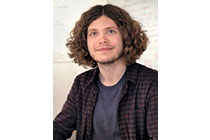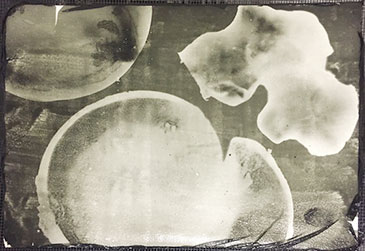Matthew Beach

PhD student
Telephone: +44 (0)20 7882 2744
Room Number: Bancroft Building, Room 2.08
Profile
Personal website: http://matthewbeach.org/
Twitter: @matthewjbeach
Instagram: @matthewjbeach
I am an artist-researcher working at the intersection of discourses around place, the photographic, and care in more-than-human worlds. My practice spans between more ‘traditional’ humanities research outputs in the form of research publications and conference presentations, as well as artistic outputs in the form of printmaking, sculpture, and short films.
My broad discursive research interests include materialisms, ethics of care, more-than-human enquiry, science and technology studies, and participatory art models and criticism.

Photogram of cast and set gelatine objects onto leather coated with handmade silver gelatine emulsion.
PhD Research
PhD Working Title
Connective Tissues: (Un)lively Materialities of Gelatine and Collagen
My PhD project was constructed and proposed from my background in visual art and photographic theory, specifically around ‘materialist’ photographic practice engaging and examining with the construction of photographs themselves. Gelatine and collagen are materials without which historical photographic films and papers could have been produced. They continue to be prevalent in the production of visual imagery, such as through paper sizing and paper coating. Gelatine and collagen are produced from the connective tissues of animals, and each generally appear as tasteless, odourless, small, slightly-yellow granules or powder. Collagen is processed for slightly longer and at higher temperatures, changing its amino acid structure in order to make it cold-water soluble.
In addition to photographic materials, gelatine and collagen are found in numerous other areas of industrial and consumer technologies and industries, including in ballistics, beverage production, prosthetics, surgical materials, cell cultures, forensics, and demolition to name a few. These biological materials have a sustained use over human history in an expansive array of spaces and locales, and they have not been the subjects of research in the humanities or social sciences. My project studies these materials and their related commodities, divided into two major focus points:
- the late industrial period into the early 20th century in the United States and Great Britain, emphasising advances in agricultural sciences and legal developments in industrial standards and regulations
- gelatine and collagen’s applications across three major market areas: culinary/cosmetic, technical, and medical
Within these focus points, gelatine’s materiality is engaged with methodologically in two primary ways:
- Archival research takes place within the US and UK’s National Archives, various local archives, and multinational corporate archives in order to understand the increase in gelatine-based products in the late industrial period and early 20th century
- Multi-sited work explores the three species of jellyfish, with each species being used as new raw living material sources to produce gelatine and collagen
A secondary line of enquiry, acting as interludes between the primary empirical materials, involves practice-based research in the form of a series of participatory art events. This aspect of the project offers another scale at which gelatine and collagen are consumed for personal human and nonhuman animal use, as well as a way to think through undermining or intervening in existing industrial standards and regulations.
Overall these varied approaches allow entanglements between objects and bodies at local, national and global scales to be examined via gathered source material throughout the project across gelatine and collagen’s culinary/cosmetic, technical, and medical markets. Scaling between locally embodied experiences and international bodies provides an analytical device to both understand gelatine and collagen’s wider historical developments, as well as focus in on a selection of products, animals, accounts, and experiences for more in-depth study. In doing so, a collection of stories with a lively temporality can be woven together, advancing knowledge about gelatine and collagen, materiality, and the human-animal relations therein.
Supervisors
- Catherine Nash
- Kathryn Yusoff
Conference Presentations
- ‘Planting an Urban Physic Garden: Intimacy, Haptic Creativity, and the Case of Phytology’, 2019, Art in the Anthropocene, Trinity College Dublin, Dublin, Ireland
- ‘Planting an Urban Physic Garden: Intimacy, Haptic Creativity, and the Case of Phytology’, 2019, AAG Annual Meeting Marriott Wardman Park Washington DC, USA
- ‘Shepherding, Marking, and Kinship; Notes on Engaging a Region through Artmaking’, 2018, Rendering the invisible Visible: engaging with human⇆nonhuman interconnectedness through research and practice, University College London, London, UK
- Historical Geographies of Care in Wartime Britain’s Women’s Land Army, 2018, RGS-IBG Mid Term Conference, Royal Holloway, University of London, London, UK
PhD Funding
- Queen Mary, University of London Research Studentship (fees and maintenance)
Other Funding Awards
- Grant from Pathway 10 of the London Interdisciplinary Social Science Doctoral Training Partnership (Grant Lead Applicant: Professor Kavita Datta)
- Expedition Fund, Queen Mary, University of London, London, UK
- Drapers Company Prize, Queen Mary, University of London, London, UK
- Conference Bursary, Historical Geography Research Group, London, UK
- Staff Development Grant, City and Guilds of London Art School, London, UK
- Walter Oldershaw Award, Queen Mary UoL, London, UK
- Saas-Fee Summer Institute of Art Tuition Scholarship, Berlin, Germany
- Florida Bright Futures Tuition Scholarship, FL, USA
- Jerry Uelsmann Studio Art Scholarship, Gainesville, FL, USA
Academic Background
- MA Geography, Queen Mary, University of London
- MFA Fine Art Media, University College London
- BFA Creative Photography, University of Florida